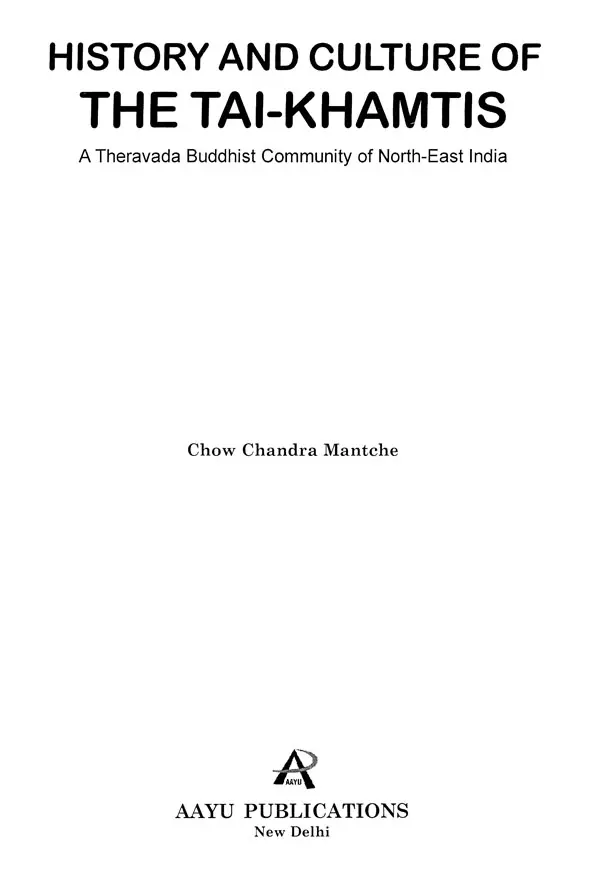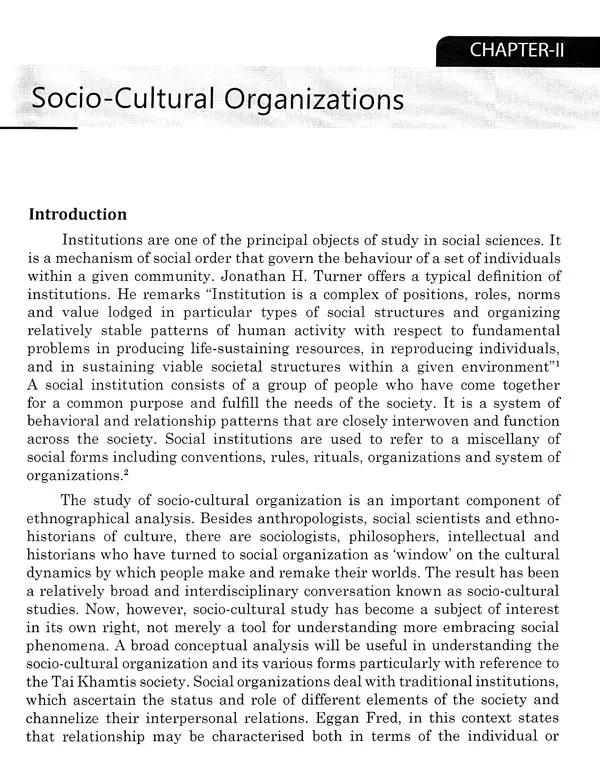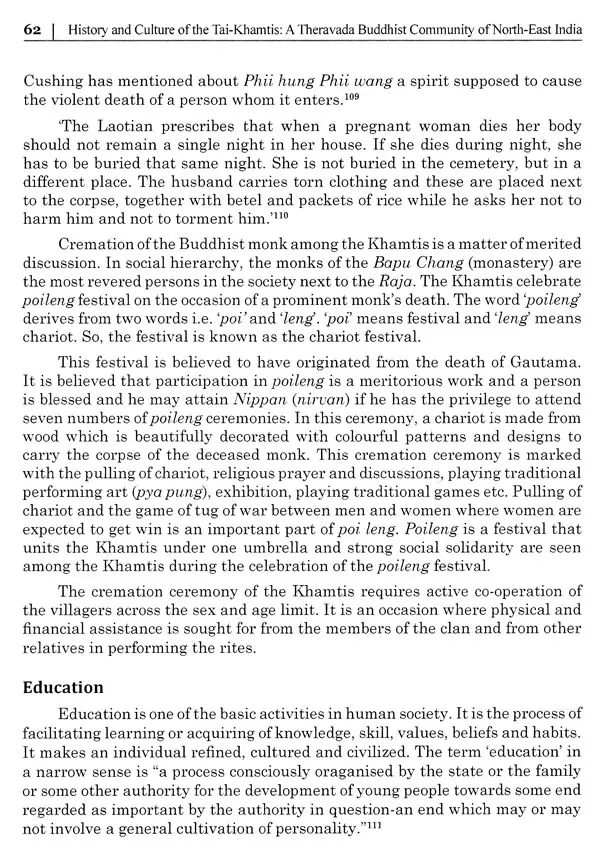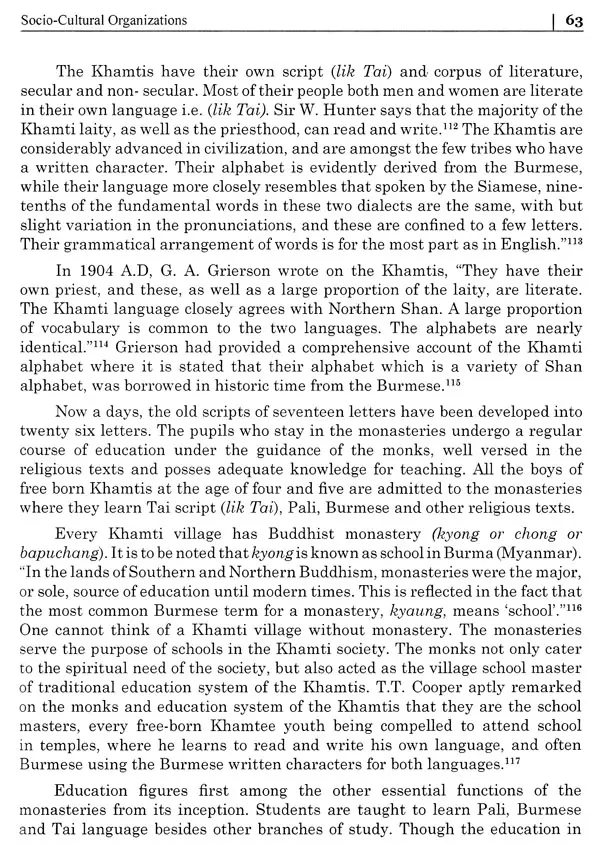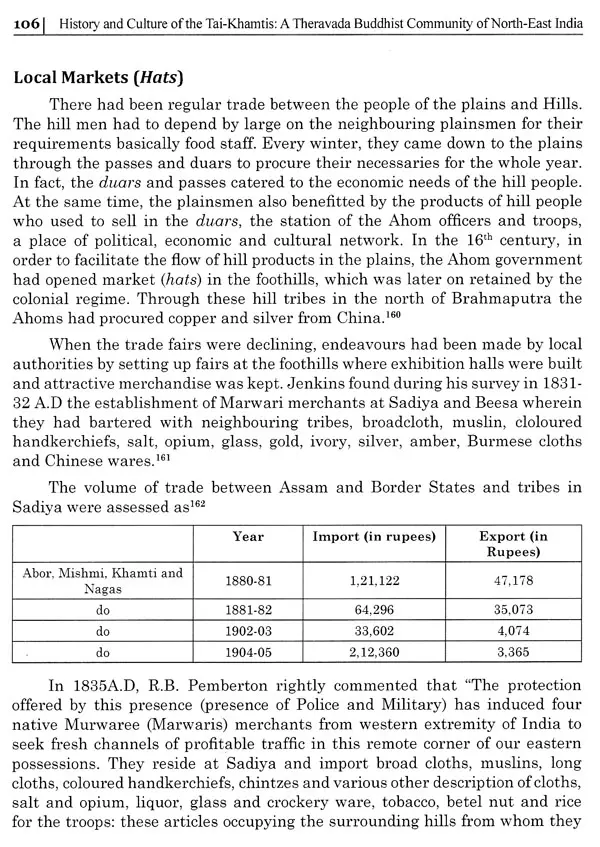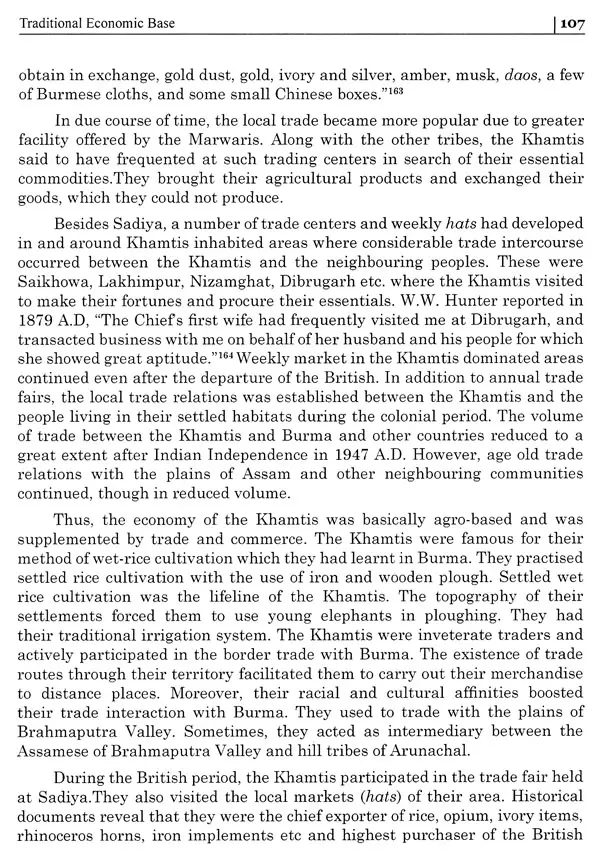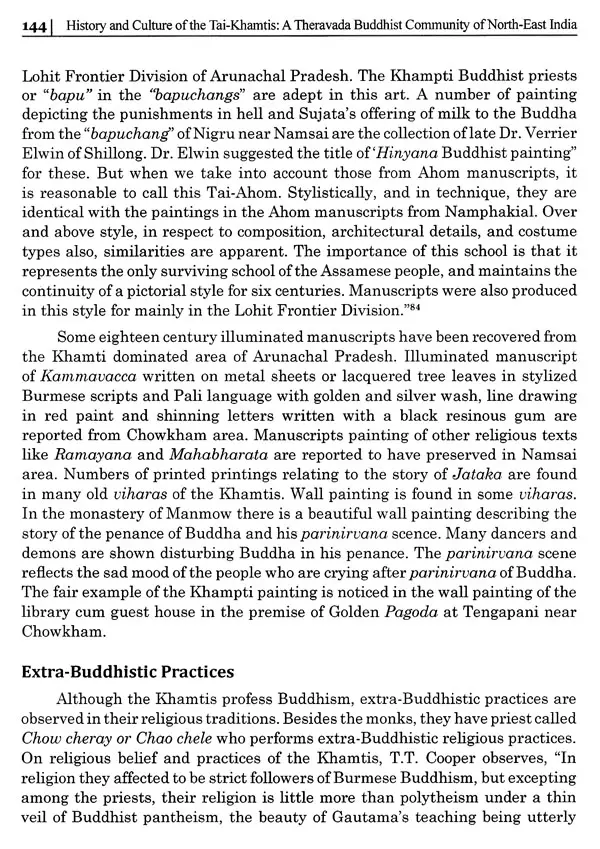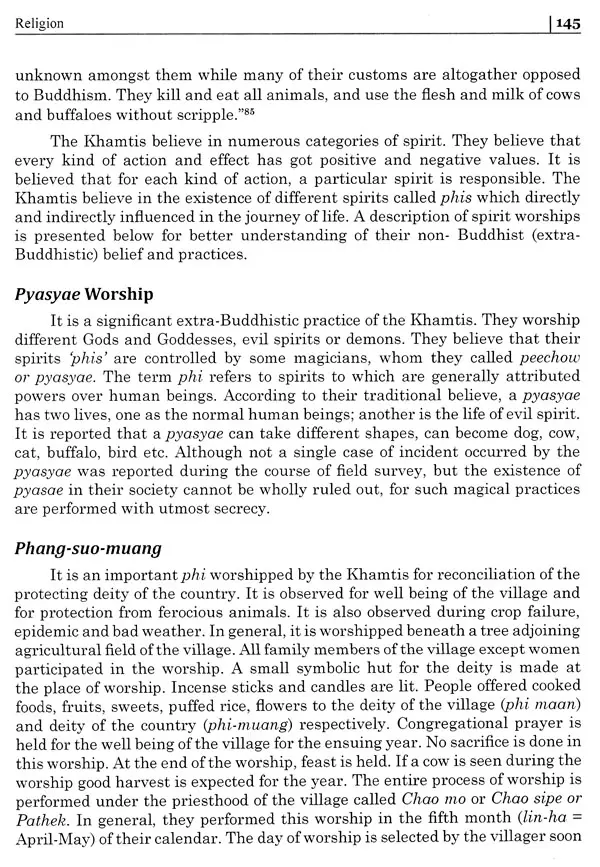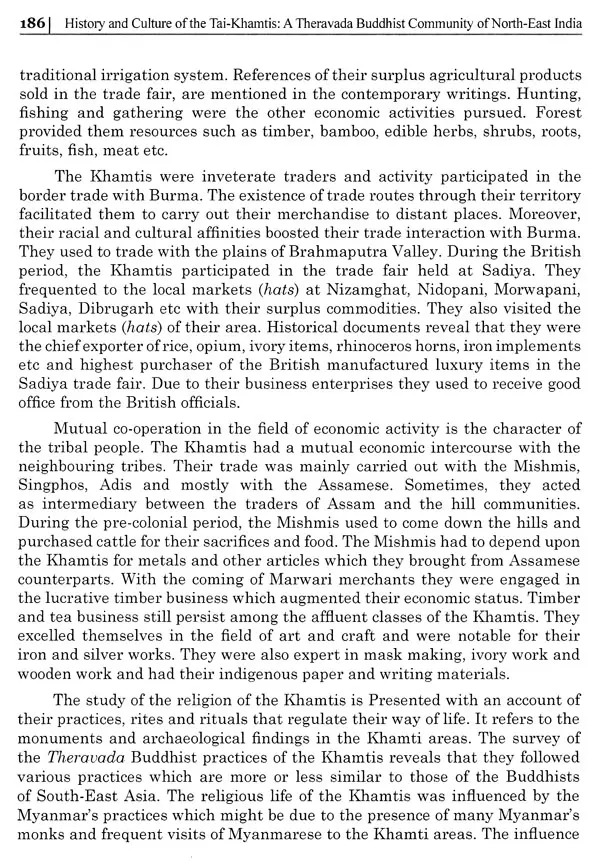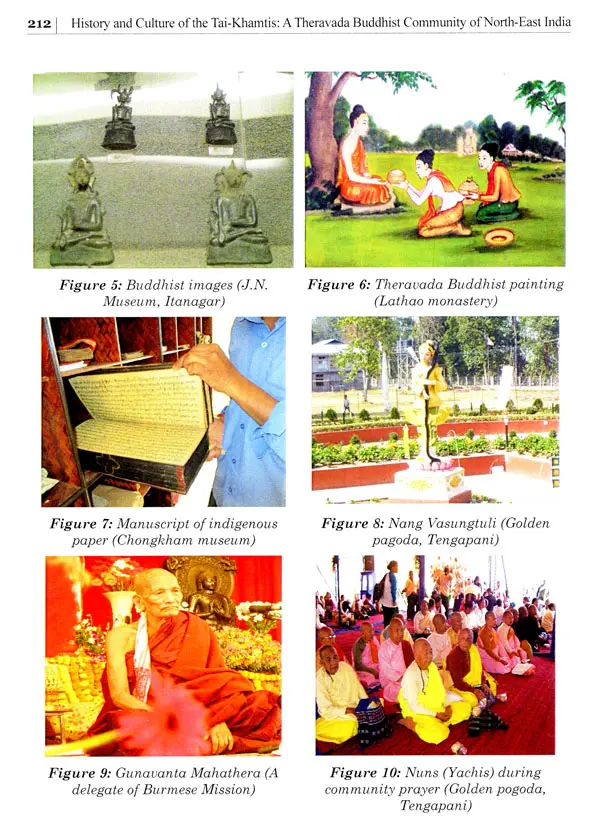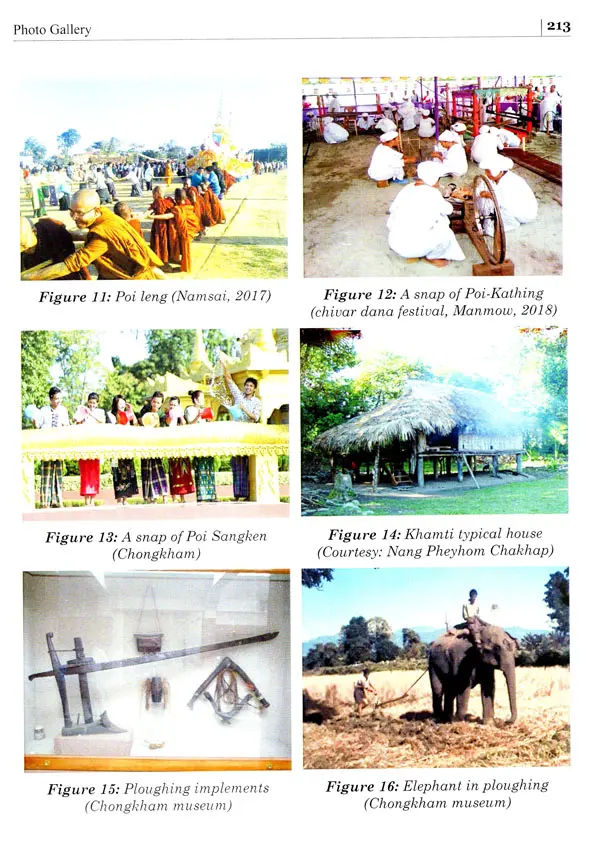
History and Culture of The Tai-Khamtis (A Theravada Buddhist Community of North-East India)
Book Specification
| Item Code: | UAP244 |
| Author: | Chow Chandra Mantche |
| Publisher: | Aayu Publications, New Delhi |
| Language: | English |
| Edition: | 2020 |
| ISBN: | 9788193945087 |
| Pages: | 223 (Throughout Color Illustrations) |
| Cover: | HARDCOVER |
| Other Details | 10.00 X 8.00 inch |
| Weight | 640 gm |
Book Description
This is the first comprehensive work on history and culture of the Tai-Khamtis, a Theravada Buddhist community of North East India. The work takes into account on the origin, migration, migrational routes, settlement pattern, socio-cultural organizations, traditional economic base and religion of the Tai- Khamtis. It also deals on the political relations of the Tai-Khamtis with the Ahoms and the British. The book can be useful for the students, research scholars and those who are interested in the history of Theravada Buddhist Communities of North-East India. The volume fills up the gap in the history of North-East India in general and Arunachal Pradesh in particular. The explorative work provides a new insight of the Theravada Buddhist community of North-East India and its historical and cultural relation with South East Asia.
Chow Chandra Mantche is an Associate Professor in the Department of History, North Lakhimpur College (Autonomous), Lakhimpur, Assam. He has more than twenty five years of teaching experience and published. a number of research articles in National and International Journals on history, culture and religion of the Theravada Buddhist communities of North-East India. He has published a book on the life and philosophy of Gandhiji and contributed chapters on cultural heritage of the Tai-Khamtis to many volumes.
Buddhism contributed a lot to India's art and culture. It gave a new philosophy to Indian religious thought. Evolved in India, Buddhism played a significant role in extending India's culture all over Asia. From third century B.C. it gained the popularity in Ceylon, Burma, Malay, Indo-China and Indonesin, With spirit of amity and toleration, the religion succeeded in binding entire South-East Asia with Indian sub-continent into a common cultural zone In the later medieval part of the 18th century, few Theravada Buddhist ethnic communities of South-East Asia migrated to north east India. In northeast India, these groups are settled in various pockets of Assam, Arunachal Pradesh and Manipur. Their cultural heritage is reflected in their dances, festivals, religion, rituals, belief and practices, art and crafts, way of life, material culture etc. They are instrumental in popularizing Theravada Buddhism in this part of our nation. In this context, the Theravada Buddhist communities are significant. Living Theravada forms an important part of Indian culture.
Among the Theravada Buddhist communities, the Tai-Khamtis are prominent. They are the largest Theravada Buddhist community of Arunachal Pradesh practicing their religion after Burmese school. They contributed a lot towards the socio-cultural life of the state. Their tangible and intangible cultural heritage bears traits of South-East Asia in general and Myanmar in particular.
Although, research on Buddhism started much earlier in India, there is hardly any substantial work dealing with the Theravada Buddhism and Buddhist communities of north east region. The early references of Theravada Buddhist communities including the Khamtis of present day Arunachal Pradesh are to be found in the Buranjis of medieval Assam. The Medieval Buranjis of Assam mainly focus on political relations of the Ahoms with the Khamtis. After establishment of British rule in Assam, the study on the ethnic communities of the region began. The British administrators, academicians, explorers, tour officers started writings on the communities of north east India. Here, mention may be made of R.B. Pemberton (1835), John M'Cosh(1837), M. Martin(1838), W. Robinson (1841). J. Butler(1847), E.T. Dalton (1872), T.T. Cooper (1873). W W. Hunter (1879), John F. Michell (1888), A. Mackenzie (1884). L.A. Waddell (1901), G.A. Grierson (1904). E.A. Gait (1905), L. W Shakespear (1914), Robert Reid (1942) etc. No doubt, the colonial writers focus sea on various facets of life and culture of the Khamtis, their narratives are explorative in nature and anthropological in treatment. After Independence of India, a host of Indian scholars started writings on the tribal life of the region. Among these scholars, who had highlighted the life and culture of the Khamtis, Verrier Elwin (1958), H.K. Barpujari (1970), Lila Gogoi (1971), Maheswar Neog (1984), Bhikshu Kondinya (1986), M.L. Bose (1979) are prominent. However, all these literary references by and large, don't provide us a comprehensive account of various aspects of the Khamtis relating to their history and culture. Therefore, the present work is undertaken to understand various aspects of their history and culture which is significant for the study of India's historical and cultural linkages with South-East Asia. It tries to fill up gap on some unexplored areas of the life of the Tai-Khamtis of Arunachal Pradesh. Moreover, this attempt would provide the necessary background for further study on tribal politics and institutions of the region.
During entire journey of the work, I am enriched by valuable suggestions, help and support from different persons. First of all, I would like to offer my indebtedness to my research supervisor Prof. Byomakesh Tripathy, Indira Gandhi National Tribal University; Amarkantak who had constantly monitored my work, offered valuable suggestions and made numerous corrections because of which the work is brought to the light of the day. I am indebted to him for kindly writing "Forward" to the volume.
I take this opportunity to record my sincere appreciation to my wife Mrs. Indrance Bordoloi for her constant support and assistance extended during my explorations of various libraries to collect relevant materials and scrutiny of the proofs of the book. I am indebted to Dr. Narendra Pd. Mahapatra, Associate professor in English, Madhab Dev University, Assam for his tireless efforts in reading the proofs of the work within a very short time. I feel highly grateful to my mother Mrs. Prema Mantche who is the spring of inspiration in my academic life. I offer my heartiest thanks to Mr. Deep Bhuyan and Mr. Arup Konwar who help me in typing. My thanks goes to Mr. Om Prakash Singh Proprietor & Publisher, Aayu Publications, New Delhi, for his generous and promtness in publishing the volume within a short time. Finally, I carve the pardon to the esteemed readers for any error that may have crept into the volume and expect valuable suggestions in the investigation of the topic concerned.
I am delighted to present Chaw Chandra Mantche's work "History and culture of the Tai-Khamtis" to the scholarly world. This is the first systematic and comprehensive work on various aspects of history and culture of the Tai-Khamtis, a Theravada Buddhist community of North-East India, who are said to have migrated to India in 18th century C.E. from upper Myanmar. On the basis of literary, archival and ethnographical data, the author has successfully presented an ethno-history of the community. The society, economy, polity, culture and religion of the Khamtis are investigated and documented. The Khamtis relation with the medieval rulers of Assam, the Ahoms and the British is also taken into account.
The present work is a welcome addition to the growing historical literature on ethnic communities of North-East India. The Tai-Khamtis's religion, culture and heritage have similarities with those of Myanmar and Thailand, which reflect historical and cultural linkages of North-East India with South-East asia in historical period. Dr. Mantche has provided a well researched text highlighting the tangible and intangible Buddhist heritage of the community, which forms an important aspect of Buddhist culture of India. The author, being a part of the Tal-Khamtis community, has brought to light minutely the details of traditional institutions of the community in a historical perspective.
I hope, the present work will serve as a useful reference for the students and scholars working on Buddhism and ethnic Buddhist communities of India.
Arunachal Pradesh, the land of rising Sun, earlier known as North Eastern Frontier Agency (NEFA), corresponds roughly with North East Frontier Tract of British empire in India is the eastern state of the Union Territory of India. The state covers a geographical area of 83,743 square kilometers and roughly lies between 26 28 and 29 30 North latitude and 91 30 and 97 30 East longitude. Arunachal Pradesh, the sentinel of east is contoured by Bhutan in the west. Myanmar in the east and the autonomous region of Tibet (China) in the north and Brahmaputra valley of Assam in the south. According to the census of 2011, the state has a total population of 13,83,727 out of which 7, 13,912 are males and 6.69.815 are females. It has a sex ratio of 900 female per 1000 male. The literacy rate of the state is 65.38% out of which the literacy rate of male is 72.55% and that of the female is 57.7%. The density of population is 17 per square km. The percentage of total tribal population is 82.64% At present; the number of district is twenty five, which have been bifurcated from former five districts namely Kamang, Subansiri, Siang. Lohit and Tirap.
River System
Like other hilly states, Arunachal Pradesh is covered by innumerable rivers, rivulets and streams flowing through out the year. There are nearly 45 rivers and number of streams of which many of them are snow fed. There are five major rivers in Arunachal Pradesh, these are Kameng, Subansiri. Siang. Lohit and Tirap. The original five district of the state are named after these rivers flowing through the respective districts.Starting from the western part of the state, the first notable river is the Nyanjang Chu, also called Dorgen which draws the water from Mela ridge. Next is the river Namka Chu known as Tawang Chu. One of the major rivers of the western sector of Arunachal is the Kameng river which runs from the north to south and after a number of sharp right angle turns in its lower reaches, it joins the Brahmaputra river in Assam. The river starts at the Kameng range at a height of 3000 meters and is fed by the Dirang river, which flows through the Sela pass. Important tributaries of Kameng river are Tenga, Bichom, Papua and Rupa river. The Rupa river runs through the Sherdukpen hills and joins the Kameng rivers. In Assam, Kameng river is known as Jia Bharali, The river of the eastern Kameng hills flow in the south-westerly direction and the river in the western region flow in the south-easterly direction.
Book's Contents and Sample Pages
